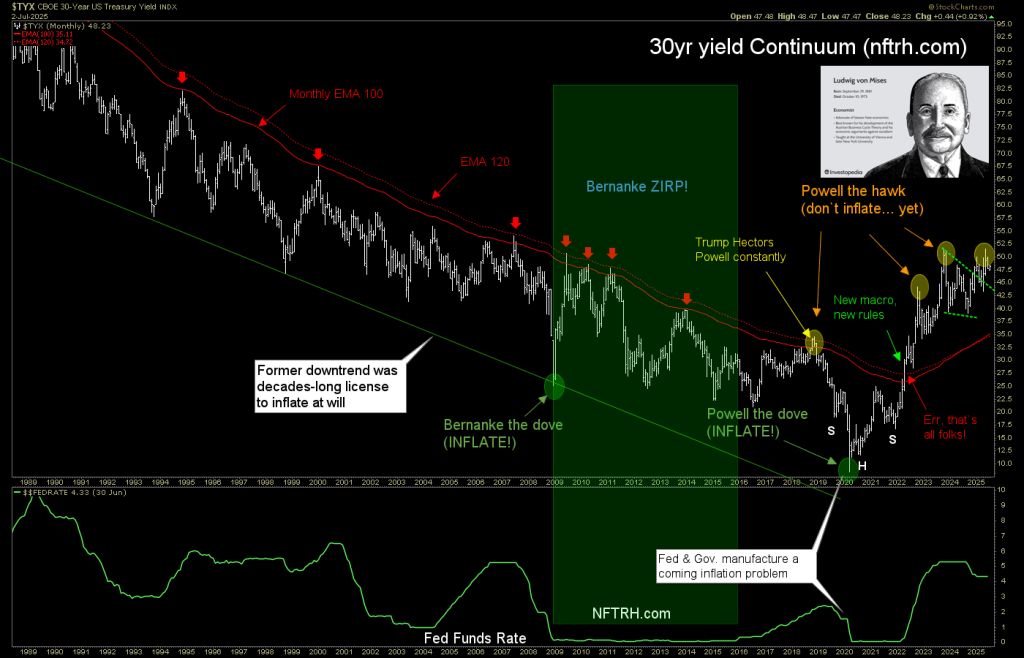IonQ CRO Alameddine Rima sells $4.6m in shares
Credit expansion, AKA more and more debt, into von Mises‘ Crack-Up-Boom would bring Stagflation at best, and Hyperinflation at worst in the not too distant future
Today’s better than expected Payrolls number is just a number. Real? Cooked up? To be revised? Whatever it is, it is in alignment with the article below, written before the data release. It’s a boom, after all!
At more than $36 trillion and due to be pushed toward $40 trillion by the big, beautiful debt bill, the United States is booming baby, booming! Great again, beautiful and will you look at those stock markets, ticking new highs!
Easy now, a Crack-Up-Boom is when credit (along with its evil twin, debt) runs amok. As a whole, our system creates credit and shoves it out into the economy. See The U.S. is Not a Capitalist Country for more on our debt-for-growth addiction in the age of Inflation onDemand, kicked off by Sir Alan the Monetary a quarter century ago.
The effects of a Crack-Up Boom are impairment of the economy while at the same time the currency is slowly (and then not so slowly) abandoned due to debt-fueled inflationary abuse. Increasingly, casino patrons are compelled to indiscriminately buy assets because the currency is known to be actively compromised.
If nothing else, take note of the Continuum’s breakout in 2022. Crack-Up Boom on…

…because long-term interest rates are on, and long-term interest rates are on due to a saturation of inflationary policy that was systematically employed every time that asset markets would liquidate. Until the epic 2020 crash in inflation indications, i.e. the brief but most intense, sharp (and ill-fated) deflationary episode since the Continuum’s birth in the 1980s.
The red moving averages kept inflationary macro signaling in lockdown for many years. We used those markers successfully * as tolerance points every time a hysteria of some sort had people thinking the bond market was dead (yields would break out). Well, in 2022 it finally was dead. The Continuum said so.
- Counterintuitively, our thesis has been that the Continuum’s gentle decades-long downtrend (disinflationary signaling) gave license to the Fed to inflate the system at every market liquidation.
- Liquidation of what should have been (but was not allowed to be) a natural boom cycle in favor of a natural bust cycle.
- Instead, it was just a previously inflated cycle deflating and awaiting the next pump job from Policy Central.
- We have been in an ongoing cycle of boom/bust, debt creation and asset appreciation. Debt-for-growth, shall we say.
The Treasury market is saying “enough shenanigans!” and in its big picture breakout, tells us that any disinflation or deflationary pressure would be counter the major trend, which is inflationary. Now, with a compliant bond market in the dustbin of history, the effects of coming inflationary policies (Fed and government) are going to be ever more corrosive. Like Stag corrosive.
NFTRH began holding a constructive view of commodities a couple months ago, when we began preparing for silver to bottom and turn up vs. gold. Commodities are favored, but the stock market can also participate in the boom for a while, although I’d expect under-performance going forward due to the economically corrosive effects of Stagflation.
I am not one to pump you. You’d have to see the perma commodity super-cycler down the street for that. I report what I see. In 2022 I saw the Continuum’s message of the previous three decades change abruptly. Since then the task has been to correctly interpret this new macro. That effort continues to this day. But a little help from Ludwig von gives us a big head start on where I think we are going.
My view is that if there is no market correction and no further softening in headline economic data, the Crack-Up Boom is on. The other option is for a market correction/bear phase first, which would trigger more inflationary policy, which would resume the Crack-Up Boom.
Either way, as we define the inflationary macro, effective strategy to capitalize on it comes to the fore. We have several indications and markets/market relationships in play we track weekly to stay on the right course.
